The Bear River Massacre Site
Introduction
Text-to-speech Audio
Images
Monument constructed by the Daughters of Utah Pioneers at the site
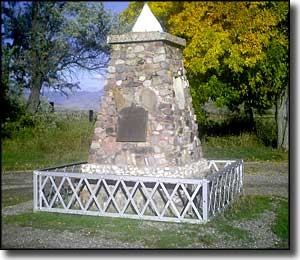
Sign at the entrance of the Bear River Massacre Site
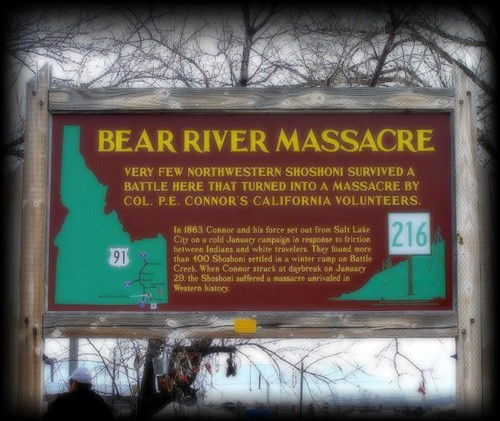
Mae Timbimboo Parry (1919 - 2007)
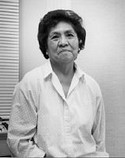
Returning from the Battle of Bear River

Edmond J. Fitzgerald/Jimmy Emerson A portrait of the Bear River Massacre.
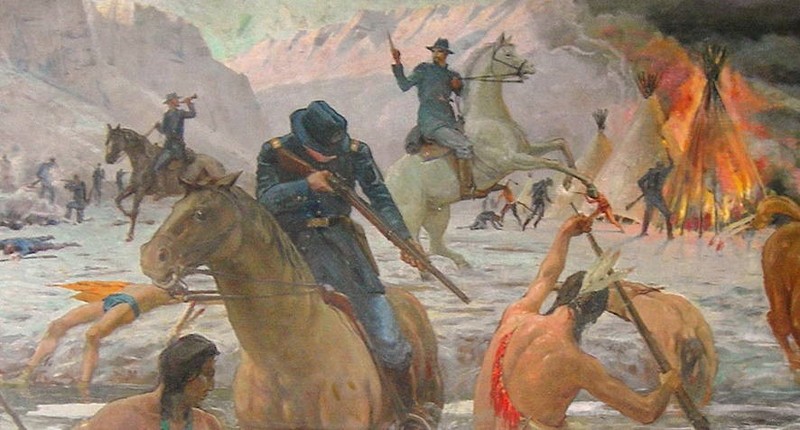
The location of the Bear River Massacre
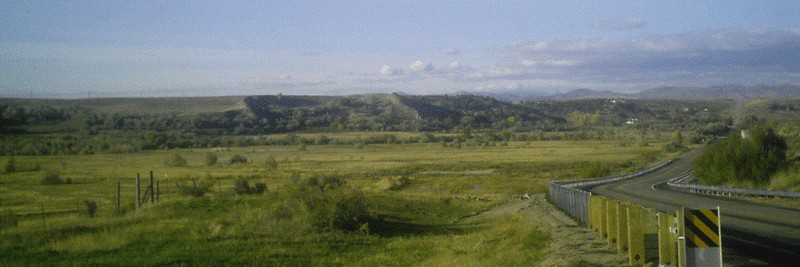
Backstory and Context
Text-to-speech Audio
The Shoshone used the lands of Cache Valley to hunt-and-gather food and sustain their way of living for many generations. In 1860, Mormons began invading the land erecting farms and raising livestock, depleting Shoshone resources. When the food source became scarce, out of desperation the Shoshone begged for food or raided farms, stole cattle, or attacked immigrants along the Oregon Trail. The Mormon settlers retaliated with violence killing some of the Shoshone. As a result of the tensions, Colonel Patrick Edward Connor was called in to resolve the situation; he made it known he planned to take no prisoners.
Colonel Conner enlisted California Volunteers into his army in preparation to deal with the rising tensions between the Mormon settlers and the Shoshone tribe. The Colonel and 200 U.S. soldiers launched an attack on a group of Northwestern Shoshone camped along the Bear River. There were two attempts made by Connor and his men. The first attempt acquired casualties on Connor’s men because the Shoshone had been standing guard and were ready. By the second attempt Connor and his men were better prepared, resulting in a very different outcome. The troops surrounded the camp and began shooting. The battle began at 6:00 am but by 8:00 am the Shoshone ran out of ammunition. Connor and his men continued to attack unarmed Shoshone. When the shooting stopped, the troops walked through the Shoshone camp and raped or killed surviving women and children. Before leaving, the troops burned the homes, stole the horses, and took the wheat of the Shoshone.
The Northwestern Shoshone Tribe was led by Chief Sagwitch Timbimboo at the time of the massacre; he was the beacon for his people to follow during the encounter, conflict, and negotiation. Some of the Shoshone were able to survive by running away, hiding in bushes, or by being taken prisoner. Chief Sagwitch was amongst one of the survivors. Sagwitch rode back and forth on his white stallion to the mothers hiding beneath the riverbank. The mothers had been forced to let their babies drift away so their cries would not attract the blood-thirsty soldiers. After the massacre Chief Sagwitch sought aid from Brigham Young and the Mormon Church. Most of the Shoshone settled elsewhere, like Fort Hall Reservation or the Wind River Reservation, with very few remaining in the Cache Valley area. The few that remained were able to make peace and live side-by-side with the Mormons until present day. In fact, Sagwitch and 100 of his men were later baptized into the Mormon Church.
The recent work of Native American people has been of tremendous value in building a richer and more varied set of perspectives on the massacre. One such person was Mae Timbimboo Parry, the granddaughter of Yeager Timbimboo, who was one of the few survivors of the Bear River Massacre. Mae Parry was born in 1919 and raised in Washakie, an Indian farming community located in northern Utah established for survivors of the Bear River Massacre. Mae was known as a storyteller, who told her grandfather’s story and shared information about the Shoshone heritage at schools and community presentations. Parry passed away at the age of 87 years old. Parry was a devoted historian who made sure that important dates and events in her tribe’s history were recorded for future generations. Because of Parry’s committed advocacy, the name that was once given to this historical event was changed in 1990 from Battle of Bear River to The Bear River Massacre. Parry was able to share the story of this tragic event with listeners through her readings and conversations. Her stories included details such as the efforts of Chief Sagwitch during the attack. Also, many years after the massacre, and with the help of Mae Timbimboo Parry, the remaining Shoshone band was baptized in the Bear River, into the LDS Church. One of the members was baptized after his death because of his fear of water.
Darren Parry, a Shoshone leader and author, serves as a chairman for the northwestern band of the Shoshone Nation and happens to the grandson of Mae Perry. Darren’s memories consist of sitting at the feet of his grandmother as a child, to listen to the stories of their people. Parry felt that the stories his grandmother told him and wrote down had to be shared with the world. Mae Parry’s plans to write a book telling the story of the massacre from the perspective of the Shoshone Nation, was thwarted when she died of Parkinson’s disease before the book could be written. Parry carried on his grandmother’s memory in retelling her perspective of the Bear River Massacre in his book The Bear River Massacre: A Shoshone History published November 25, 2019. During an interview on the Access Utah talk show with Tom Williams, Parry says of writing his book, “It’s a story that we don’t have in our history books today, we don’t learn about it in our curriculum at school but I think it’s important that we should.” From Parry’s perspective the Shoshone people did not die in a gruesome blood bath, rather the massacre gave his people a rebirth.
Two plaques on a pillar beside the highway were erected by the Daughters of Utah Pioneers, one in 1932 and another in 1953. Darren Parry had a vision to build an interpretive center to illuminate what happened at the Bear River Massacre location. The Utah Economic Development Appropriations Committee ranked the interpretive center fourth on the list of 380 submitted requests. It was recommended by the committee that $750,000 would be needed for the center. Utah’s Executive Appropriations Committee must approve this before Parry will have the funding in hand, but the project was recommended by the Utah Economic Development Appropriations Committee as one of the top 50 project they recommend for the one-time funding in 2019. An interpretive center at the Bear River Massacre location would have a great impact on tourism and the economy of Idaho, but it would mean so much more to the descendants of the Shoshone people. Parry’s efforts are to build the center to carry on not only his grandmother’s stories but to share the history of the Shoshone people with the world. Although the Bear River Massacre has long since passed the effects of this historic moment in time is far from forgotten.
Sources
"Bear River Massacre", accessed on November 20, 2014. http://www.historytogo.utah.gov/utah_chapters/american_indians/bearrivermassacre.html "In Remembrance of the Bear River Massacre", accessed on November 20, 2014. http://www.lemhi-shoshone.com/bear-river-massacre.html
Eaton, Daysha. Forgotten Shoshone Massacre Story Will Soon Be Told On Grand Scale , Kuer.org. January 31st 2019. Accessed April 15th 2020. https://www.kuer.org/post/forgotten-shoshone-massacre-story-will-soon-be-told-grand-scale#stream/0.
Artist: Mae Timbimboo Parry, Utahdcc.force.com. Accessed April 15th 2020. http://utahdcc.force.com/public/PtlArtifacts?field=artApp__Artist__c&value=a0j70000000BlfcAAC&heading=Mae%20Timbimboo%20Parry.
1863: Bear River Massacre, utah.gov. Accessed April 15th 2020. https://ilovehistory.utah.gov/time/stories/bear_river.html.
Thatcher, Elaine. The Bear River Massacre, utahhumanities.org. January 25th 2013. Accessed April 15th 2020. https://www.utahhumanities.org/stories/items/show/258.
Dimuro, Gina. The Forgotten Bear River Massacre May Be The Deadliest Native American Slaughter Ever, ati. July 9th 2018. Accessed April 15th 2020. https://allthatsinteresting.com/bear-river-massacre.
(Harkins, 2020)
(Williams, 2020)
(SEAMONS, 2019)
(Thomas, 2020)
(Evidence, 2019)
